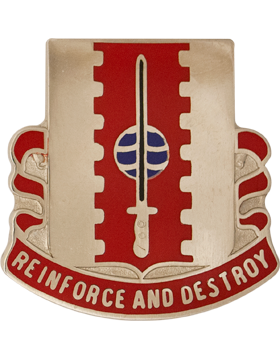About 386th Engineer Battaliont386th Engineer Battalion
MOTTO: Reinforce and Destroy
The origins of the 386th date back to Company A, Texas Engineers, organized in Port Arthur in 1916, followed by Company B shortly after, redesignated from artillery to engineers. The entire Texas engineer unit was called to federal service on August 15, 1917. The Engineers were redesignated as the 111th Engineer Regiment in October, 1917 with the First Oklahoma Engineer battalion included to form second battalion of the regiment. Included in the ranks of the 111th were "400 cowboys", including most of Company C, First Battalion, from Sweetwater. The unit completed the work begun at Camp Bowie, building a road system and the "Benbrook trench system". The Benbrook trenches stretched, upon completion, for more than ten miles along both sides of the Texas and Pacific Railroad southwest of Fort Worth.
The was called upon for service in the World War and arrived in France in July, 1918, assigned with the 36th Division to the Bar-sur-Aube, assigned Corps Engineers for the First Corps in September, repairing roads, filling captured trenches and building bridges. The regiment spent most of October following the American advance, providing vital road building work as the armies advanced, ending the war near Sedan. Clearing German mines in the line of advance was a particularly dangerous part of the work of the unit. The unit was mustered out of service at Camp Bowie, Fort Worth, Texas, in May, 1919 and reorganized as an all-Texas unit, 1922. Continuous service until mobilized in 1940.
The Regiment was inducted into federal service for the Second World War as part of the 36th Division at Fort Worth, Texas, and moved to Camp Bowie, Brownwood, Tx, where 1st Bn was redesignated 111th Engineer Battalion (Combat) and 2d Bn was resdesignated 2d Bn 176th Engineers on 31 Jan 42. The 111th trained with the 36th and made overseas deployment from New York on 2 April 1943, arriving in North Africa on 13 April, 1943. Landed at the Salerno Beachhead, 9 September, 1943, and accompanied the 36th Division as Division Engineers in the landings in Southern France, 15 August, 1944, the Loire Valley, Vosges, Alsace, and the Danube Valley, ending the war near the German Austrian border on 7 May, 1945. The unit was awarded campaign credit for Naples-Foggia, Anzio, Rome-Arno, Southern France, Ardennes, Alsace, and Central Europe. The unit returned to the United States in December, 1945 and was deactivated at Camp Miles Standish, Massachusetts, on 26 December, 1945.
Continuing the lineage, of the 2d Battalion, 111th Engineer Regiment, the 386th Engineer Battalion was reactivated and reorganized in the post World War II period, with various units of the Battalion being organized in 1947, 1948 and 1949, assigned to the 49th Armored Division. Through the 386th; the lineage of the 176th Engineer Combat Battalion were continued, with campaign credits for Lyete (with arrowhead) and Ryukus campaigns in the Pacific during World War II. Companies C, D and E had been organized after World War II as units of the 176th Engineer Combat Battalion, Texas National Guard. On 15th of March, 1955, all units of the 176th and 386th were redesignated as HHC, Company A, B, C, D, and E of the 386th Combat Engineer Battalion.
On September 19, 1961, the 386th Engineer Battalion was mobilized with the rest of the 49th Armored Division as part of national defense activities relating to the "Berlin Crisis". The unit was deployed to Fort Polk, Louisiana, on 24 October, 1961, after training at home stations. After completing extensive maneuvers entitled "Iron Dragoon" in May, 1962, the unit was demobilized in June 1962, and returned to state service where the 386th was continued in assignment to the 49th Armored Division. Today the 386th is an element of the 36th Infantry Division.
The 386 Engineer Battalion deployed to Iraq in late 2004 with the 278th Armored Cavalry Regiment from Tennessee as part of Operation Iraqi Freedom and assigned to Task Force Liberty. The activation marked the first time the unit had been activated since 1961, during which time it served for approximately a year at Fort Polk as a result of the Berlin crisis.

The 386th Engineer Battalion Distinctive Unit Insignia, also called a “unit crest” or DUI, was approved on 16 December 1982. “Reinforce And Destroy,” the Battalion motto, is perhaps the most concise encapsulation of an Engineer unit’s mission ever crafted. Red and white are used almost exclusively for the insignia and are the branch colors of the Corps of Engineers.
A vertical band in the center of the insignia, known as a “pale,” in heraldry, is embattled (much like the top of a fortified castle wall) and symbolizes the defensive construction duties of an Engineer unit (“Reinforce”). A disc with wavy blue and white bands, known in heraldry as a fountain, is an allusion to the unit’s home area of Houston, and the bayonet atop the fountain is an allusion the unit’s numerous battle honors and decorations.